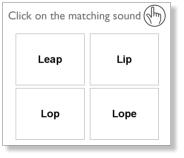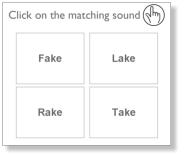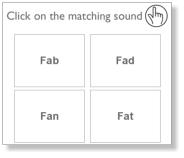


This is an advanced module targeted at improving speech perception in the presence of
background noise. This module is appropriate for experienced users to improve speech
understanding in background noise. Two advanced training protocols are used: phoneme-in-noise
protocol and keyword-in-sentence. The background noise includes six-talker speech babble,
speech-shaped steady noise, and white noise. All procedures use closed-set with 4-alternative
choices.
Group 1: Adaptive Medial Vowel Recognition in Noise Training
This training group is similar to the vowel recognition training group in the basic
module except that it is performed in the presence of background noise. The signal-to-
noise ratio varies according to the response from the subject. If the subject responds
correctly, the signal-to-noise ratio is reduced by 2 dB. Each session includes 25 trials
and there are four choices in each trial. During each trial, there is one monosyllabic
word (initial consonant+medial vowel+final consonant). The initial consonant and final
consonant are the same for all four choices. The medial vowel is different for the four
choices. A typical example of four alternative choices is: "bat", "but", "bit", "bet". This
training group will allow the listener to concentrate on the middle vowel sound of each word in the presence of
background noise.
Group 2: Adaptive Initial Consonant Recognition in Noise Training
This training group is similar to consonant recognition training group in the basic
module except that it is performed in the presence of background noise. The signal-to-
noise ratio varies according to the response from the subject. If the subject responds
correctly, the signal-to-noise ratio is reduced by 2 dB. Each session includes 25 trials
and there are four choices in each trial. During each trial, there is one monosyllabic
word (initial consonant+medial vowel+final consonant). The medial vowel and final
consonant are the same for all four choices. The initial consonant is different for the
four choices. A typical example of four alternative choices is: "cat", "pat", "fat", "rat".
This training group will allow the listener to concentrate on the initial consonant sound of each word in the
presence of background noise.
Group 3: Adaptive Medial Consonant Recognition in Noise Training
This training group is similar to consonant recognition training group in the basic
module except that it is performed in the presence of background noise. The signal-
to-noise ratio varies according to the response from the subject. If the subject
responds correctly, the signal-to-noise ratio is reduced by 2 dB. Each session
includes 25 trials and there are four choices in each trial. During each trial, each
choice represents one monosyllabic word (initial vowel +medial consonant+final
vowel). The initial vowel and final vowels are the same for all four choices. The
medial consonant is different for the four choices. A typical example of four
alternative choices is: "ubu", "uru", "ufu", "udu". This training group will allow the listener to concentrate on the
medial consonant sound of each word in the presence of background noise.
Group 4: Adaptive Final Consonant Recognition in Noise Training
This training group is similar to consonant recognition training group in the default
basic module except that it is performed in the presence of background noise. The
signal-to-noise ratio varies according to the response from the subject. If the subject
responds correctly, the signal-to-noise ratio is reduced by 2 dB. In the other words,
the signal-to-noise ratio is increased by 2 dB. Each session includes 25 trials and
there are four choices in each trial. During each trial, each choice represents one
monosyllabic word (initial consonant+meidal vowel+final consonant). The inital
consonant and medial vowel are the same for all four choices. The final consonant is
different for the four choices. A typical example of four alternative choices is: "bat", "ban", "bag", "bad". This
training group will allow the listener to concentrate on the final consonant sound of each word in the presence of
background noise.
Group 5: Adaptive Number Recognition in Noise Training
This training group is similar to number recognition training group in the basic
module except that the current training is performed in the presence of background
noise. The signal-to-noise ratio varies according to the response from the subject. If
the subject responds correctly, the signal-to-noise ratio is reduced by 2 dB. In the
other words, the signal-to-noise ratio is increased by 2 dB. Each session includes 25
trials and there are four choices in each trial.
Group 6: Adaptive Everyday Sentence Recognition in Noise Training
This training group is similar to sentence recognition training group in the default
basic module except that it is performed in the presence of background noise. The
signal-to-noise ratio varies according to the response from the subject. If the subject
responds correctly, the signal-to-noise ratio is reduced by 2 dB. Each session
includes 25 trials and there are four choices in each trial.





























